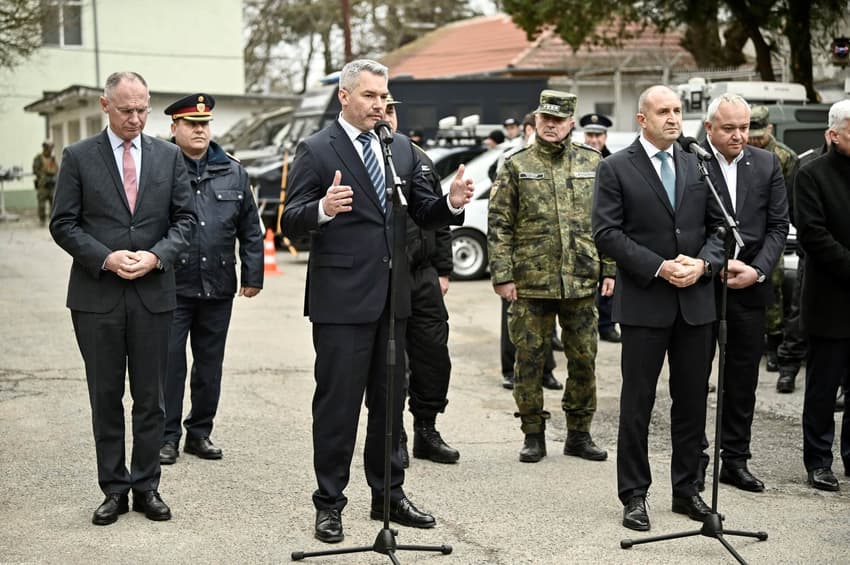What's the reason behind the drop in Austrian asylum seeker claims?

Austria has seen a 49% decrease in asylum applications compared to this this time last year. But what's the reason for the fall?
Until the end of October 2023, 53,641 applications for asylum had been lodged for the year, according to the Austrian interior ministry and reported by DPA.
This marks a significant shift, with Austria having experienced the highest surge in asylum applications throughout the European bloc in 2022.
The Interior Ministry has indicated several factors contributing to the reduction in application numbers.
The first is increased border controls. The Local reported earlier this month that the Austrian government began checking the passports of those passing through the country's eastern border with Slovenia.
Part of a larger cooperative project between several European nations, the border checks were reinforced with increased police surveillance across the Slovenian border length, constituting approximately 150 kilometres.
Another factor that has reduced the number of applications is increased security controls throughout Serbia.
Austria has deployed over one hundred law enforcement officials, alongside several other European nations to assist in the Balkan nation, which remains an important route for smugglers. A particular focus of these officials is patrolling the country's border with Hungary.
READ MORE: What's the reason for Austria's recent border clampdown?
Alongside the drop in those seeking asylum, Austria's government also announced that deportations were up 25 percent on the same time in 2022.
Until the end of October, 10,478 deportations occurred, with 5,496 (52 percent) being voluntary and 4,982 under force.
As a central European nation linking Eastern Europe and the Balkans with more affluent countries in Western Europe, Austria has long struggled with managing the passage of migrants through the country's borders.
The majority of asylum seekers arrive in the eastern state of Burgenland and originate from Afghanistan, India, Syria, Tunisia and Pakistan.
Earlier this month, Karl Nehammer's governing coalition signed an agreement with the UK government to cooperate on border security issues and potentially outsource asylum-seeker processing to Rwanda - before that policy was ruled unlawful by the UK Supreme Court and the EU Commission.
Earlier this year, Nehammer visited Turkey and Bulgaria, pledging to assist those countries in securing their borders and requesting more support from the EU Commission.
Comments
See Also
Until the end of October 2023, 53,641 applications for asylum had been lodged for the year, according to the Austrian interior ministry and reported by DPA.
This marks a significant shift, with Austria having experienced the highest surge in asylum applications throughout the European bloc in 2022.
The Interior Ministry has indicated several factors contributing to the reduction in application numbers.
The first is increased border controls. The Local reported earlier this month that the Austrian government began checking the passports of those passing through the country's eastern border with Slovenia.
Part of a larger cooperative project between several European nations, the border checks were reinforced with increased police surveillance across the Slovenian border length, constituting approximately 150 kilometres.
Another factor that has reduced the number of applications is increased security controls throughout Serbia.
Austria has deployed over one hundred law enforcement officials, alongside several other European nations to assist in the Balkan nation, which remains an important route for smugglers. A particular focus of these officials is patrolling the country's border with Hungary.
READ MORE: What's the reason for Austria's recent border clampdown?
Alongside the drop in those seeking asylum, Austria's government also announced that deportations were up 25 percent on the same time in 2022.
Until the end of October, 10,478 deportations occurred, with 5,496 (52 percent) being voluntary and 4,982 under force.
As a central European nation linking Eastern Europe and the Balkans with more affluent countries in Western Europe, Austria has long struggled with managing the passage of migrants through the country's borders.
The majority of asylum seekers arrive in the eastern state of Burgenland and originate from Afghanistan, India, Syria, Tunisia and Pakistan.
Earlier this month, Karl Nehammer's governing coalition signed an agreement with the UK government to cooperate on border security issues and potentially outsource asylum-seeker processing to Rwanda - before that policy was ruled unlawful by the UK Supreme Court and the EU Commission.
Earlier this year, Nehammer visited Turkey and Bulgaria, pledging to assist those countries in securing their borders and requesting more support from the EU Commission.
Join the conversation in our comments section below. Share your own views and experience and if you have a question or suggestion for our journalists then email us at [email protected].
Please keep comments civil, constructive and on topic – and make sure to read our terms of use before getting involved.
Please log in here to leave a comment.